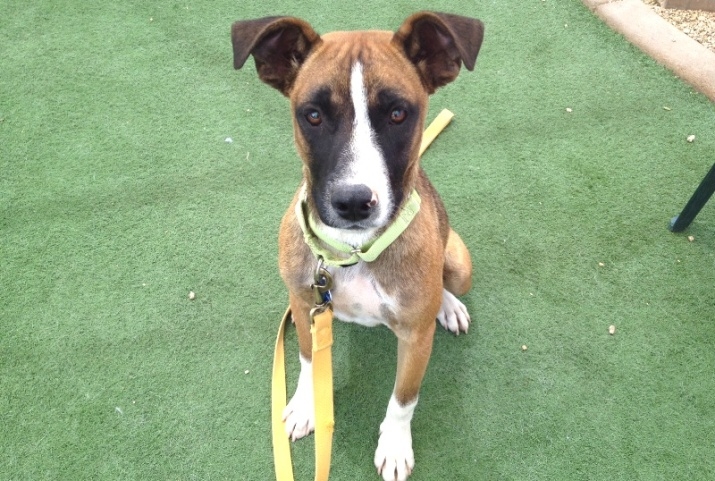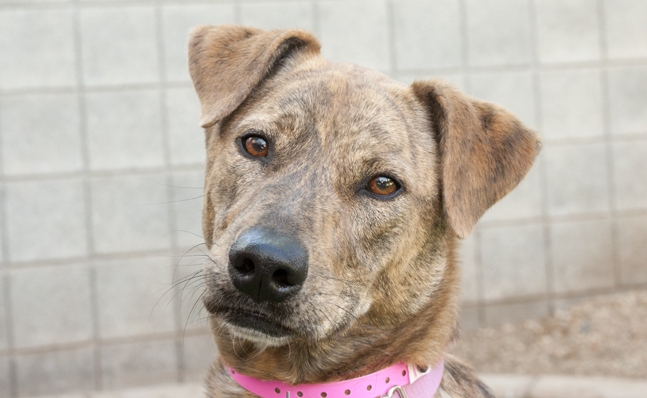A Rover by any other name
Removing breed labels from shelter dogs beneficial for both canines and humans

No bones about it: Pit bulls get a bad rap.
The breed’s unfortunate history — which includes their use in bull-baiting and dog fighting — has detrimentally influenced public opinion of them as inherently aggressive. More recently, media reports that incorrectly label dogs who bite and attack humans as pit bulls have only served to reinforce the stereotype.
“In my opinion, there’s an issue with the public’s perception of pit bulls,” said Lisa Gunter, a third-year psychology doctoral student conducting research in the Canine Science CollaboratoryThe Canine Science Collaboratory is housed in Arizona State University’s Department of Psychology, an academic unit of the College of Liberal Arts and Sciences. at ASU. “It’s a very divisive issue. People have really strong feelings on both sides.”
Gunter recently published the results of a series of four studies on the breed in the journal PLOS-1, titled “What’s in a Name? Effect of Breed Perceptions & Labeling on Attractiveness, Adoptions & Length of Stay for Pit-Bull-Type Dogs.”
The impetus behind the studies, said Gunter, was simple: She wanted to help dogs find their way out of shelters and into their forever homes. To do that, she and her team first had to prove that the negative perception of pit bulls phenomenon was real. Then, they had to test ideas for different types of interventions that could change that negative perception.
In the first study, participants were shown photos of dogs that looked like pit bulls (but may or may not have been) as well as photos of dog breeds more traditionally kept as family pets, like Labrador retrievers and border collies. They were asked a series of questions when viewing each dog, such as how comfortable they would feel approaching it, how friendly it looked, how intelligent it looked and whether they would consider adopting it.
“That first study helped us confirm what our suspicions were, that pit bulls would be perceived negatively by the participant,” said Gunter. “That parallels what we see in society about how people view pit bull dogs.”
There was a silver lining, though. When participants were shown photos of pit-bull-type dogs accompanied by a human handler, it “profoundly” changed their perception for the better, Gunter said.
“I was surprised at how just putting a person in the photograph can make a difference,” she added, noting that photos of dogs on shelter websites almost never include a human handler, the addition of which she suggests could make a big difference in helping to find that dog a home.
The second study asked participants to compare photos of pit bulls with photos of dogs that were phenotypically similar (pit bull “look-alikes”). Gunter and her team found no difference in the perceived attractiveness between the two groups of dogs.
The third study used video recordings of pit bulls and look-alikes playing at shelters. In some videos, the breeds were labeled; in others they were not. Results showed people’s perceptions of the dogs changed based on whether or not the breed was labeled — that is, the pit bull label negatively impacted the perceived attractiveness of the dogs. What’s more, the research showed that negative perceptions had a much stronger impact on decision-making — such as whether to adopt a dog — than positive perceptions.
The fourth and final study used real data from an animal shelter that had stopped labeling the breed of adoptable dogs. Gunter and her team compared data collected over a couple of years that looked at lengths of stay and outcomes for all dog breeds, including pit bulls, before and after the change in labeling practice. What they found suggested that overall, breed labeling influences potential adopters' perceptions and decision-making.
The whole practice of breed labeling is problematic to begin with, explained Gunter, because we’re just not that great at identifying them. And getting rid of the practice is something that can help all dogs.
“Shelter dogs are almost always mixed-breed dogs,” she said. “We don’t know their heritage; we may not even know their background. So the conclusion we formed after these studies is how important it is to evaluate the individual dog that’s in front of you.”
At that point, the dog’s breed becomes less important, and it’s more of a conversation about whether a particular dog’s personality fits with someone’s lifestyle.
“Without breed labels, the dog can be whoever [a potential adopter] wants them to be,” Gunter said. “That’s a pretty powerful thing. If that dog looks like a cocker spaniel and reminds them of their dog from childhood, then great. It’s that dog to them. And when it becomes a conversation, that’s what can hopefully get more dogs out of shelters and into good homes.”
Top photo by Odan Jaeger/Freeimages.com
More Science and technology

ASU researchers develop special microphone to verify human speech
Deepfakes have become a large societal concern with the advent of video and audio content generated by artificial intelligence, or AI. A deepfake is a convincing imitation that blurs the lines…

Leading students toward a future of renewable energy
Nicholas Rolston, assistant professor in the School of Electrical, Computer and Energy Engineering, one of the Ira A. Fulton Schools of Engineering at Arizona State University, has found his passion…

SPARCS mission spacecraft bus delivered to ASU for final assembly
The Arizona State University team that is building the NASA-funded Star-Planet Activity Research CubeSat, or SPARCS, cleared a major milestone this week — receiving its spacecraft bus at the School…





